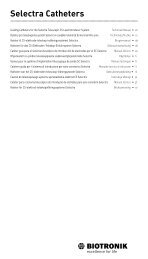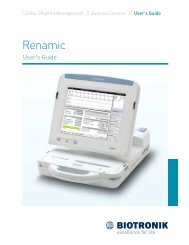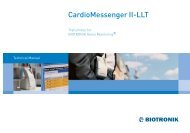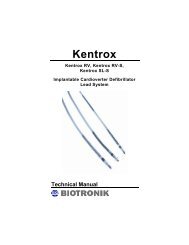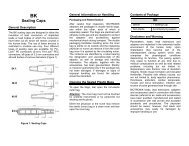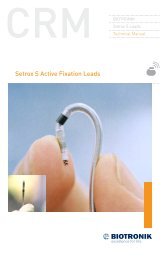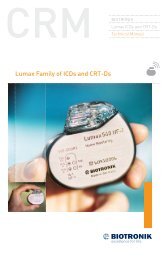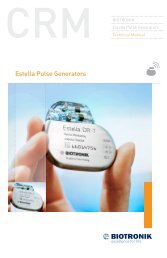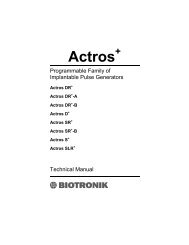Lumax Family of ICDs and CRTâDs - BIOTRONIK USA - News
Lumax Family of ICDs and CRTâDs - BIOTRONIK USA - News
Lumax Family of ICDs and CRTâDs - BIOTRONIK USA - News
You also want an ePaper? Increase the reach of your titles
YUMPU automatically turns print PDFs into web optimized ePapers that Google loves.
36 <strong>Lumax</strong> <strong>Family</strong> Technical Manual<br />
Table 10: Complications at 6‐Months (Excluding LV Lead Related)—<br />
Study versus Control<br />
Category<br />
Study<br />
N=133<br />
Control<br />
N=67<br />
Difference<br />
Study vs<br />
Control<br />
Procedure Related 6 (4.51%) 2 (2.99%) 1.53%<br />
Atrial Lead Related 3 (2.26%) 1 (1.49%) 0.76%<br />
ICD Lead Related 3 (2.26%) 0 (0%) 2.26%<br />
LV Lead Related 11 (8.27%) 1 (1.49%) 6.78%<br />
Device Related 7 (5.26%) 5 (7.46%) ‐2.20%<br />
Other Medical Related 9 (6.77%) 2 (2.99%) 3.78%<br />
Total Procedure, Lead<br />
<strong>and</strong> Device Related<br />
27 (20.30%) 8 (11.94%) 8.36%<br />
Total 35 (26.32%) 10 (14.93%) 11.39%<br />
The pulse generator related complication rate is higher in the control<br />
group as compared to the study group. The complication rates for<br />
procedure related, atrial lead related, ICD lead related, LV lead related<br />
<strong>and</strong> other medical related are higher in the study group as compared to<br />
the control group.<br />
1.6.2.9 Post hoc Safety Analysis Conclusion<br />
There are no clinically substantial differences in the total complication<br />
rate or in the rates for the different complication rate categories<br />
between the study <strong>and</strong> the control group.<br />
Table 11 compares this post‐hoc Safety Endpoint analysis to previous<br />
CRT‐D clinical studies:



